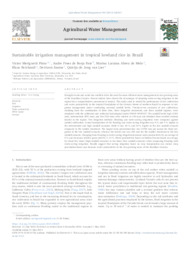Sustainable irrigation management in tropical lowland rice in Brazil.
Sustainable irrigation management in tropical lowland rice in Brazil.
Autoria: PINTO, V. M.; REIS, A. F. de B.; MELO, M. L. A. de; REICHARDT, K.; SANTOS, D.; VAN LIER, Q. de J.
Resumo: Drought events and water use conflicts drive the need for more efficient water management in rice-growing areas of the Brazilian Cerrado. Recent studies have shown the advantages of adopting water-saving irrigation in the region but a comprehensive assessment is needed. This study aims to model the performance of rice cultivation and water productivity in the tropical floodplains of the Cerrado biome of northern Brazil in response to irrigation management under contrasting seasonal rainfall levels. Twenty-seven scenarios of rice cultivation, resulting from the combination of three sites, three irrigation treatments, and three rainfall regimes, were simulated with the calibrated and validated hydrological model SWAP/WOFOST. The rainfall levels high (1501 mm), intermediate (952 mm), and low (510 mm) were relative to 120 days and obtained from weather stations located in the region. Two irrigation methods (flooding and water-saving irrigation) were compared against rainfed cultivation. Actual transpiration of the flooding and water-saving irrigation was 9 % and 4 % higher in the intermediate and high rainfall scenarios while it was 30 % and 20 % higher in the low rainfall scenario compared to the rainfed treatment. The largest deep percolation loss was 12700 mm per season for flood irrigation in the low rainfall scenario, whereas the lowest one was 349 mm for the rainfed treatment in the low rainfall scenario. Changing from flooding to water-saving irrigation increases water productivity by an average of 9 % and decreases relative grain yield by 5-12 %. Water productivity based on bottom flux increased on average by about five times (high rainfall scenario) to ten times (low rainfall scenario) when comparing flooding with water-saving irrigation. Results suggest that saving irrigation based on crop transpiration can reduce deep percolation losses and increase water productivity in the rice-growing areas of the Brazilian Cerrado.
Ano de publicação: 2023
Tipo de publicação: Artigo de periódico
Unidade: Embrapa Pesca e Aquicultura
Palavras-chave: Arroz, Cerrado, Irrigação, SWAP model, Water productivity
Observações
1 - Por padrão são exibidas publicações dos últimos 20 anos. Para encontrar publicações mais antigas, configure o filtro ano de publicação, colocando o ano a partir do qual você deseja encontrar publicações. O filtro está na coluna da esquerda na busca acima.
2 - Para ler algumas publicações da Embrapa (apenas as que estão em formato ePub), é necessário ter, no celular ou computador, um desses softwares gratuitos. Sistemas Android: Google Play Livros; IOS: iBooks; Windows e Linux: software Calibre.
Acesse outras publicações
Acesse a Base de Dados da Pesquisa Agropecuária (BDPA) para consultar o acervo completo das bibliotecas da Embrapa.

